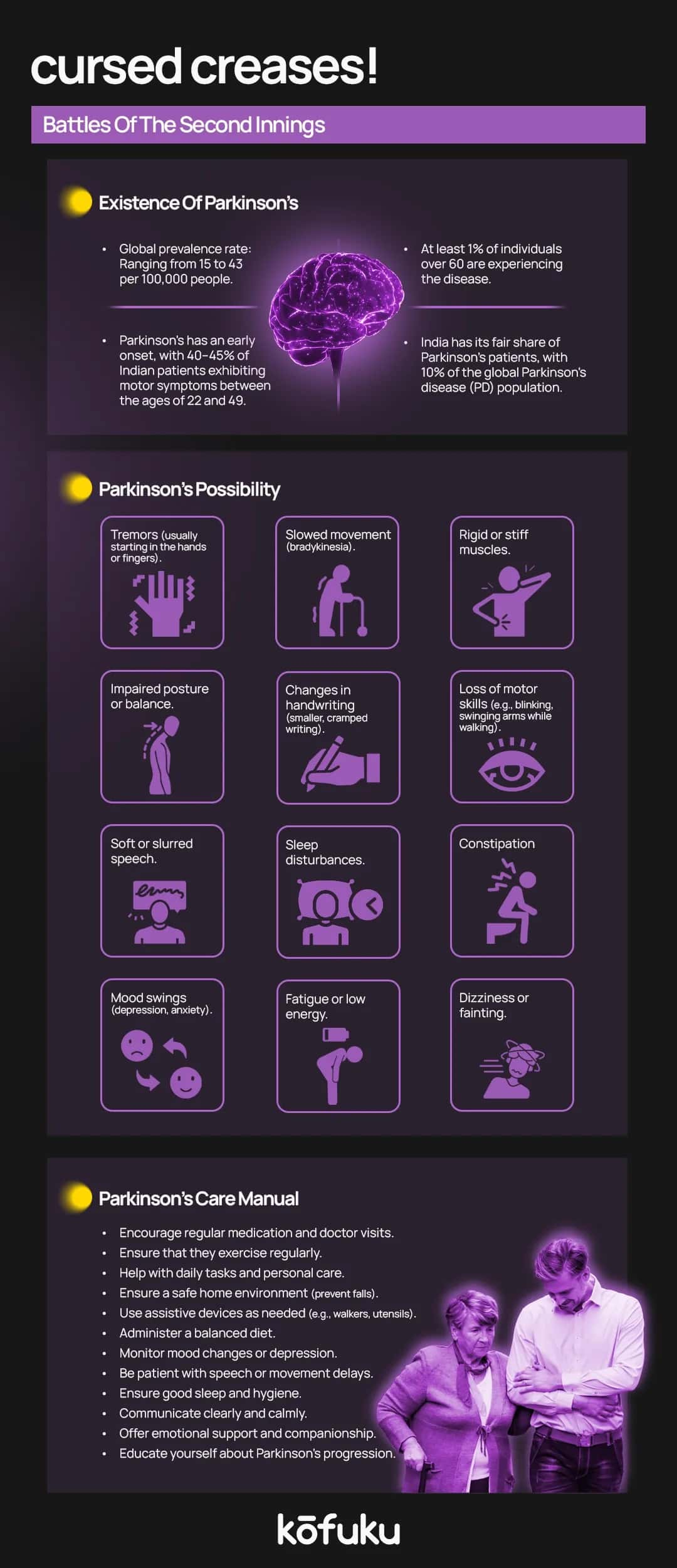Parkinson’s Disease - Everything You Need To Know

Introduction
We have seen Parkinson’s Disease in so many movies and so many television shows that we tend to feel that we know it. “Does he have Parkinson’s? Oh! It must be very difficult!” we say to anyone who listens! In our heads, we know all about it!
But do we?
We know the shaking and tremors, but do we know how difficult it is for them to button their shirts? We surely know that their muscles become rigid, but do we know how difficult they find it to raise a finger? We have seen them struggle with balance, but what about their inability to stand for a short period without losing their balance?
I’ll not even get into the myths!
It's time we unlearned and then relearned Parkinson’s disease. In a way that will not only tell us why it is difficult for people suffering from this disease, but also how difficult it actually is.
What Is Parkinson’s Disease?
Parkinson’s is a movement disorder of the central nervous system that gets worse over time. Our nervous system is a complex network of nerve cells that controls several body parts, including movement.
Symptoms begin slowly. At first, there might be barely noticeable tremors in just one hand or sometimes a foot or jaw. Tremors are very common with Parkinson’s. This ailment can also cause stiffness, retardation of movement, and trouble with balance, that increases the risks of falls.
During the early stages of Parkinson’s, your face might show very little or no expression. Arms won’t swing while walking. Speech might become soft or slurred. Symptoms get worse over time.
Well, here’s the bad news. Parkinson’s disease has no cure. There are medicines, though, that help with symptoms. Sometimes, a doctor might suggest surgery to help control parts of the brain. This surgery might help bring down the intensity of symptoms.
What Are The Symptoms of Parkinson’s Disease?
The symptoms of this disease aren’t the same for everyone. Different folks show different signs. Early symptoms might be so mild that they fly under the radar. Symptoms often start on one side of the body and impact both sides. They are usually worse on one side than on the other. Some of the symptoms of Parkinson’s are similar to those of other disorders.
Tremors
It all starts with the tremors. Rhythmic and constant, it usually begins in the hands or fingers. Sometimes tremors start in the foot or jaw. People rub their thumb and forefinger back and forth. This is called a pill-rolling tremor.
The hands might tremble when at rest or when there’s stress. Patients might notice that the shaking is a little less when they do some sort of task or move around.
Slowed movement, also known as bradykinesia
Parkinson’s disease might slow down your movement, making seemingly simple tasks difficult. Suddenly, getting out of a chair, showering or getting dressed might get difficult. The face might show little expression. It might be tougher to blink as well.
Rigid muscles
The muscles in the body might stiffen. The muscles might feel tense and painful, and arm movements might be short and jerky.
Poor posture and balance
Ever notice how some older adults are constantly bent over? Parkinson’s might affect posture so that it may become stooped. People might fall or have balance issues.
Loss of automatic movements
People with Parkinson’s might notice that they are less able to make specific movements that can usually be done without thinking, like blinking, swinging the arms while walking or smiling.
Speech changes
Patients with Parkinson’s disease might speak softly or quickly, slur, or stop before talking. Their speech might become flat or monotone, devoid of typical speech patterns.
Writing changes
Patients might struggle with writing, and writing might appear cramped and small. Writing is one of the most basic things a person can do, and losing that ability can mean a big hit to your confidence.
Nonmotor symptoms
This could include anxiety, depression, sleep issues and constipation. People suffering from this ailment might act out dreams, urinate often, have issues with smelling, problems with memory and thinking and constantly feel tired.

Okay, but What Causes This Disease?
In this disease, nerve cells in the brain, known as neurons, slowly break down and die. Many of the symptoms are caused by a loss of neurons that produce a chemical messenger in the brain known as dopamine.
Reduced dopamine levels in the brain result in irregular brain activity, which causes movement problems and other symptoms of this disease. People suffering from this disease lose a chemical messenger known as norepinephrine, which is in charge of many body functions, like blood pressure.
Many factors play a significant role in this disease, including
Genes
Particular genetic changes are related to Parkinson’s disease. But these aren’t common, unless many family members have had this disease.
Environmental factors
Being exposed to certain toxins or other environmental factors could increase the risk of contracting Parkinson’s disease later. One such instance is MPTP, a substance quite common in illicit drugs, and peddled illegally as “synthetic heroin”. Other instances include pesticides and healthy water used for drinking. However, no environmental factor has proven to be a cause.
For seniors who have Parkinson’s, there are many brain changes. Researchers are currently looking into why changes happen and the roles that they play. Such changes include -
Presence of Lewy bodies
Clumps of proteins in the brain are associated with Parkinson’s disease. These proteins are known as Lewy bodies, and researchers believe they might be responsible for causing it.
Alpha-synuclein is found within Lewy bodies
Alpha-synuclein is a protein present in all Lewy bodies. It is in a clumped form that cells find difficult to break down. Right now, researchers studying Parkinson’s disease are focusing on this area. This protein has been found in the spinal fluid of people with Parkinson’s disease.
Altered mitochondria
Mitochondria refer to powerhouse compartments within cells that are responsible for most of our energy. Changes to mitochondria can result in cell damage. Such changes have been prevalent in the brains of people who have Parkinson’s disease.

Risk Factors
There are many risk factors for Parkinson’s disease. They are
Age
This disease is the enemy of the aged. The risk increases with age, starting around age 50 or older. The average age of onset is around 70. Younger adults might fall prey to this disease, but it is rare. If people younger than 50 get this disease, it is called early-onset Parkinson’s disease.
Genetics
Suppose you have multiple first-degree relatives, like parents or siblings, with Parkinson’s disease, your risk increases. But for this, you have to have many blood relatives with this condition.
Male sex
Men are more likely to get Parkinson’s disease than women. That doesn’t mean the women don’t get it. They do, it’s just not that widespread.
Being exposed to toxins
If you are by any chance exposed to herbicides or pesticides, that might slightly increase your risk of Parkinson’s disease.
Complications as a Result of Parkinson’s
People with Parkinson’s disease might face a litany of complications that could be treated.
These might include -
Issues with thinking clearly
Parkinson’s disease can impact memory, language and reasoning skills. This ailment can also result in dementia or other conditions that impact thinking. Such complications usually occur later in Parkinson's, and medication isn’t too successful in managing such symptoms.
Emotional changes and depression
Certain people can feel irritable and concerned while the disease is in its infancy. They may also have depression and anxiety. Medicine is the best recourse in these cases.
Issues with swallowing and chewing
Late-stage Parkinson’s disease impacts the oral muscles. This results in trouble with swallowing and chewing, which can result in nutrients being omitted from the diet. Food collecting in the mouth can also lead to choking and drooling.
Sleep issues and sleep disorders
People who have Parkinson’s disease might wake up often during the night, experience nightmares and fall asleep during the day.
Other Symptoms That Can Rear Their Ugly Head Include
Bladder problems
There might be some bladder problems, like urgency. Parkinson’s affects the autonomic nervous system, which controls involuntary body functions, including the bladder. The brain may lose the ability to properly signal the bladder to hold urine, leading to overactivity.
Constipation
Patients who have Parkinson’s might have a hard time passing stool. Their frequency of doing so might come down to thrice a week.
Blood pressure changes
A sudden drop in blood pressure, also known as orthostatic hypotension, can cause dizziness, lightheadedness, or even fainting if you try to stand up.
Loss of smell
Patients with Parkinson’s might fully or partially lose their sense of smell. Although the loss of smell can occur due to a number of other ailments, Parkinson’s is at the top of the list.
Tiredness
If you have Parkinson’s disease, you might feel exhausted and lack energy, especially as the day progresses.
Pain
People with Parkinson’s might experience pain or cramps in the muscles and joints. This debilitating pain might prevent them from carrying out their daily tasks.
Sexual symptoms
Suffering from Parkinson’s disease? You might experience a dip in sexual desire or performance.
So, How Do You Prevent This Disease?
Well, the cause of Parkinson’s disease is still unknown. So bad luck, you can’t prevent it. However, research shows that some factors could help you prevent it. Scientists aren’t very sure, though. The factors include.
Exercise
Aerobic exercise has many benefits, including being linked to a lower incidence of Parkinson’s disease.
Caffeine
Coffee and tea lovers unite! Studies show a link between drinking caffeinated beverages like coffee and tea and a lower risk of Parkinson’s.
Medicines
There are some medicines, such as ibuprofen and statins, that have been linked to a lower risk of Parkinson’s disease.
Conclusion
Complex, debilitating and much more - Parkinson’s disease is a condition that impacts much more than just movement. It affects the body, mind and daily life in several ways. As of now, there’s no cure.
However, ongoing research, better treatments and a superior understanding of the ailment are helping patients manage symptoms and maintain their quality of life. Support from friends, family and healthcare professionals can make a huge difference.
As science continues to explore the roots and risk factors of Parkinson's, there is hope that prevention and even a cure might one day become a reality. Until then, be kind if you see an older adult experiencing tremors. That’s the least you can do.
FAQs
Q. Can Parkinson’s disease be cured?
A. No, Parkinson’s disease currently has no cure. However, medications and therapies can help manage symptoms and improve quality of life.
Q. What is the leading cause of Parkinson’s disease?
A. The exact cause is unknown, but it is linked to the loss of dopamine-producing neurons in the brain. Genetics and environmental factors may also play a role.
Q. At what age does Parkinson’s usually start?
A. Most people are diagnosed around age 60 or older, but early-onset Parkinson’s can occur before age 50 in rare cases.
Q. Is Parkinson’s only about tremors?
A. No, while tremors are a common symptom, Parkinson’s also affects movement, balance, speech, writing, and can cause non-motor symptoms like depression, fatigue, and memory issues.
Q. How is Parkinson’s disease diagnosed?
A. There is no single test for Parkinson’s. Doctors typically diagnose it based on medical history, symptoms, and a neurological examination.






